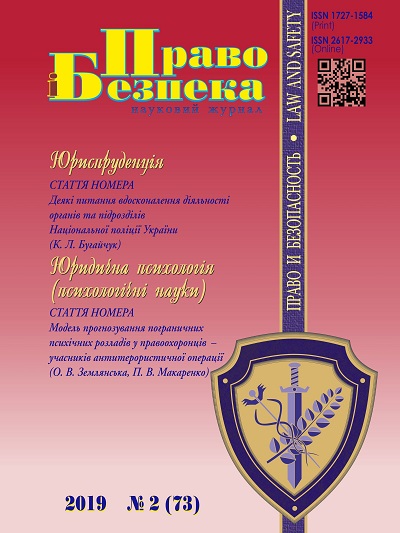Model for Predicting Borderline Mental Disorders of Law Enforcement Officers – Participants of Anti-Terrorist Operation
DOI:
https://doi.org/10.32631/pb.2019.2.02Keywords:
psychological traumatization, law enforcement officer, borderline mental disorders, stress factors, mental health, anti-terrorist operationAbstract
An analysis of the professional tasks of law enforcement officers in the context of an anti-terrorist operation suggests a significant deterioration in their psychological and physical health. Therefore, one of the relevant problems of legal psychology is the development of scientific methods for substantiating and optimizing programs for the psychological provision of the professional activities of law enforcement officers serving in such conditions (professional selection, diagnosis and support of psychological readiness, psychological support, psycho-prophylaxis, correction and rehabilitation). This is necessary to minimize the negative psychosocial consequences in the form of pronounced features of borderline mental disorders and addictive behavior with the formation of concomitant addictions to alcohol and drugs.
The authors of the article have revealed the results of constructing a model for predicting borderline stress disorders of law enforcement officers. The obtained regression coefficients and the values of weighted odds ratios for each of the scales demonstrated that the variables “Dissimulation”, “Negativism”, “Distress and maladjustment”, “Indirect aggression” and “Symptom of hyperactivity” are the most significant indicators of personal qualities that predict the formation of borderline stress disorders of law enforcement officers – participants in the anti-terrorist operation; further significant are “The presence of features of post traumatic stress disorder”, “Resentment”, “Aggravation” and, finally, “Hostility”, “Physical aggression”, “Symptoms of invasion” and “Verbal aggression”.
It has been substantiated that negativistic law enforcement officers with pronounced features of indirect aggressiveness to the environment, exaggerating the existing problems, with features of psychological maladjustment in the emotional sphere of personality are mostly exposed to the formation of borderline stress disorders.
It is advisable to use this model for predicting borderline mental disorders during routine psycho-preventive examinations of law enforcement officers of the Ministry of Internal Affairs of Ukraine in the period between business trips to anti-terrorist operation zone.
Downloads
References
Antosyk S.M., 1993. The Correlation of Activities Characteristics in Conditions of Deficiency of Time [Spivvidnoshennia kharakterystyk diialnosti v umovakh defitsytu chasu]. Abstract of Ph.D. dissertation. Institute of Psychology of the National Academy of Educational Sciences of Ukraine.
Balabanova L.M., 2001. The Category of Rule in the Study and Regulation of Human Functional States [Kategoriya normy v issledovanii i regulyatsii funktsionalnykh sostoyanii cheloveka]. D.Sc. dissertation. University of Internal Affairs.
Buchek L.I., 1993. The Analysis of Emotional Resistance as a Manifestation of the Peculiarities of Self-Regulation Personality [Analiz emotsiinoi stiikosti yak proiavu osoblyvostej samorehuliatsii osobystosti]. Abstract of Ph.D. dissertation. Taras Shevchenko National University of Kyiv.
Kolesnichenko O.S., 2018. The Basics of Combat Psychological Trauma of Soldiers of the National Guard of Ukraine [Zasady boiovoi psykholohichnoi travmatyzatsii viiskovosluzhbovtsiv Natsionalnoi hvardii Ukrainy]. Kharkiv : NA NHU.
Aksenov M.M., Zhiginas N.V. and Petrova Yu.V., 2014. Post-Traumatic Stress Disorder in Some Types of Professional Activity: Problem Statement [Posttravmaticheskoe stressovoe rasstroistvo pri nekotorykh vidakh professional`noi deyatel`nosti: postanovka problemy]. Vestnik Tomskogo gosudarstvennogo pedagogičeskogo universiteta – Tomsk State Pedagogical University Bulletin, No. 5, pp. 117-122.
Litvintsev S.V., Snedkov E.V. and Reznik A.M., 2005. Combat Psychical Trauma: A Guide for Doctors [Boevaya psikhicheskaya travma]. Moscow: Meditsina.
Potapchuk Ye.M., 2004. Theory and Practice of Maintaining of Mental Health of Military Personnel [Teoriia ta praktyka zberezhennia psykhichnoho zdorovia viiskovosluzhbovtsiv]. Khmelnytskyi: Vydavnytstvo NADPSU.
Shayhlislamov Z.R., 1997. Prediction of Emotional Stability of Employees of Internal Affairs Agencies in Extreme Conditions of Service and Operational Activities [Prognozirovanie emotsionalnoi ustoichivosti rabotnikov organov vnutrennikh del v ekstremalnykh usloviyakh sluzhebno-operativnoi deyatelnosti]. Abstract of Ph.D. dissertation. University of Internal Affairs.
Azhar M.Z. and Varma S.L., 1995. Religious Psychotherapy in Depressive Patients. Psychotherapy and Psychosomatics, Vol. 63, No. 3-4, pp. 165-168. https://doi.org/10.1159/000288954.
Voloshin V.M., 2001. Clinical Typology of Post-Traumatic Stress Disorders and Issues of Differentiated Pharmacotherapy [Klinicheskaya tipologiya posttravmaticheskikh stressovykh rasstroistv i voprosy differentsirovannoi psikhofarmakoterapii]. Psihiatriâ i psihofarmakoterapiâ – Psychiatry and psychopharmacotherapy, Vol. 3, No. 4, pp. 125-132.
Pogodina T.G., Panova I.V. and Firsov A.A., 2004. Clinico-Dynamic Features of Posttraumatic Stress Disorders in Combatants Against the Background of Consequences of Craniocerebral Trauma [Kliniko-dinamicheskie osobennosti posttravmaticheskikh stressovykh rasstroistv uchastnikov boevykh deistvii na fone posledstvii cherepno-mozgovoi travmy]. Medicinskij vestnik MVD – MIA Medical Bulletin, No. 3, pp. 31-33.
Fastovtsov G.A., Reznik A.M., Savina O.F. and Vasilevsky V.G., 2009. Clinical-Psychopathological Prerequisites of Criminal Aggression inVeterans of Local Wars [Kliniko-psihopatologicheskie predposylki kriminal`noi agressii u veteranov lokalnykh voin]. Socialʹnaâ i kliničeskaâ psihiatriâ – Social and Clinical Psychiatry, Vol. 17, No. 3, pp. 20-25.
Korolenko Ts.P. and Dmitrieva N.V., 2006. Personality and Dissociative Disorders: Expanding the Boundaries of Diagnosis and Therapy [Lichnostnye i dissotsiativnye rasstroistva: rasshirenie granits diagnostiki i terapii]. Novosibirsk: NGPU.
Epanchintseva E. M., Kazennykh T.V., Lebedeva V.F. and Bohan N.A., 2015. Clinical Structure of Mental Disorders in Participants of Local Armed Conflicts in the Long Term Postboom [Klinicheskaya struktura psikhicheskikh rasstroistv u uchastnikov loka`lnykh vooruzhennykh konfliktov v otdalennom postboevom periode]. Uspehi sovremennogo estestvoznaniâ – Advances in Current Natural Sciences, No. 1, pp. 760-764.
Irdisov K.A., 2011. PTSD in Emergency: Clinical, Epidemiological and Dynamic Aspects [PTSR v usloviyakh chrezvychainoi situatsii: kliniko-epidemiologicheskie i dinamicheskie aspekty]. Vestnik psihiatrii i psihologii Čuvašii – The Bulletin of Chuvash Psychiatry and Psychology, No. 7, pp. 21-34.
Ahaiev N.A., Kokun O.M. and Pishko I.O., 2016. Compendium of Methods for the Diagnosis of Negative Mental States of Soldiers [Zbirnyk metodyk dlia diahnostyky nehatyvnykh psykhichnykh staniv viiskovosluzhbovtsiv]. Kyiv: NDTs HP ZSU.



